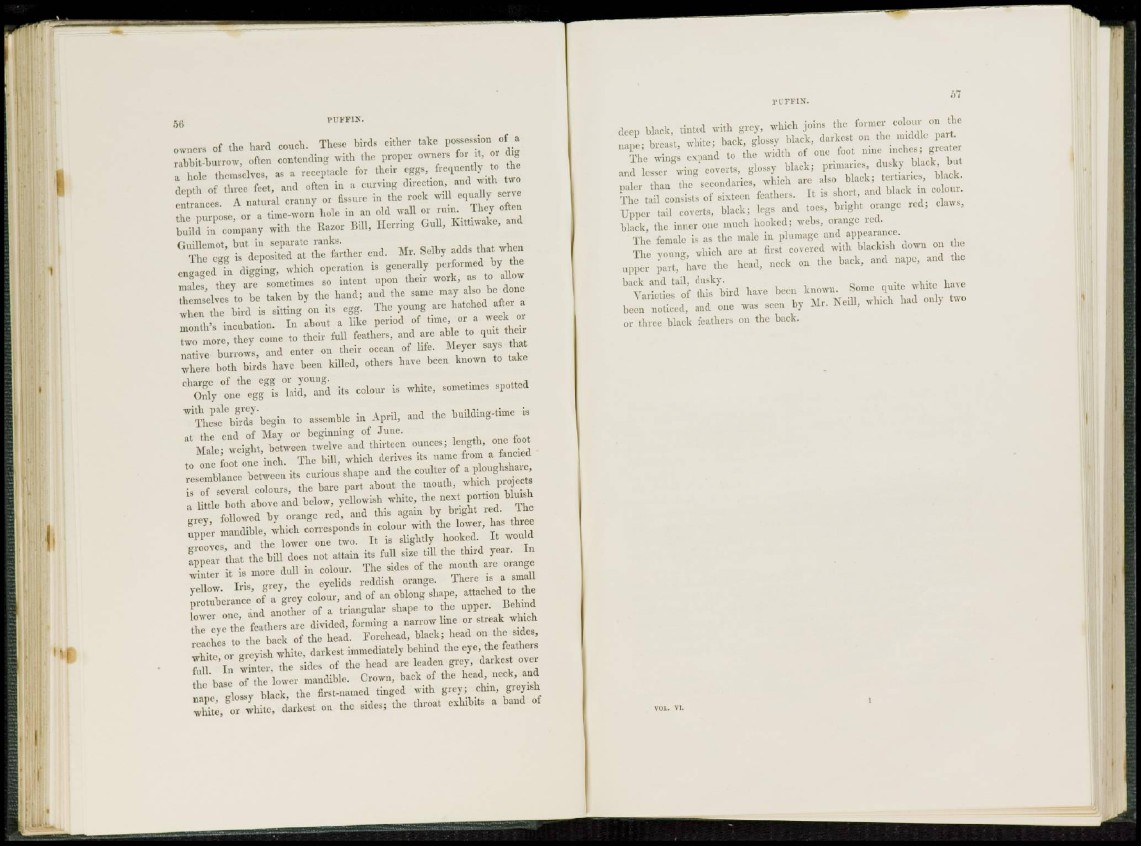
VUFF1X.
owners of the hard couch. These birds either take possession of a
rabbit-burrow, often contending with the propel owners for it, or dig
a hole themselves, as a receptacle for their eggs, frequently to the
depth of three feet, and often in a curving direction, and with two
entrances. A natural cranny or fissure in the rock will equally serve
the purpose, or a time-worn hole in an old wall or ruin. They often
build in company with the Razor Rill, Herring Gull, Kittiwake, and
Guillemot, but in separate ranks.
The egg is deposited at the farther end. Mr, Sclhy adds that when
engaged in digging, which operation is generally performed by the
males, they are sometimes so intent upon their work, as to allow
themselves to be taken by the hand; and the same may also be done
when the bird is sitting on its egg. The young are hatched after a
month's incubation. In about a like period of time, or a week or
two more, they come to their full feathers, and arc able to quit their
native burrows, and enter on their ocean of life. Meyer says that
where both birds have been killed, others have been known to take
charge of the egg or young.
Only one egg is laid, and its colour is white, sometimes spotted
with pale grey.
These birds begin to assemble in April, and the building-time is
at the end of May or beginning of June.
Male; weight, between twelve and thirteen ounces; length, one foot
to one foot one inch. The bill, which derives its name from a fancied
resemblance between its curious shape and the coulter of a ploughshare,
is of several colours, the bare part about the mouth, which projects
a little both above and below, yellowish white, the next portion bluish
grey, followed by orange red, and this again by bright red. The
upper mandible, which corresponds in colour with the lower, has three
grooves, and the lower one two. It is slightly hooked. It would
appear that the bill does not attain its full size till the third year. In
winter it is more dull in colour. The sides of the mouth are orange
yellow. Iris, grey, the eyelids reddish orange. There is a small
protuberance of a grey colour, and of an oblong shape, attached to the
lower one, and another of a triangular shape to the upper. Behind
the eye t he feathers arc divided, forming a narrow line or streak which
reaches to the back of the head. Forehead, black; head on the sides,
white, or greyish white, darkest immediately behind the eye, the feathers
full. In winter, the sides of the head arc leaden grey, darkest over
the base of the lower mandible. Crown, back of the head, neck, and
nape, glossy black, the first-named tinged with grey; chin, greyish
white, or white, darkest on the sides; the throat exhibits a band of
PUFFIN.
deep black, tinted with grey, which joins the former colour on the
nape; breast, white; back, glossy black, darkest on the middle part.
The wings expand to the width of one foot nine inches; greater
and lesser wing coverts, glossy black; primaries, dusky black, but
paler than the secondaries, which are also black; tertiaries, black.
The tail consists of sixteen feathers. It is short, and black in colour.
Upper tail coverts, black; legs and toes, bright orange red; claws,
black, the inner one much hooked; webs, orange red.
The female is as t h e male in plumage and appearance.
The young, which are at first covered with blackish down on the
upper part, have the head, neck on the back, and nape, and the
back and tail, dusky.
Varieties of this bird have been known. Some quite white have
been noticed, and one was seen by Mr. Ncill, which had only two
or three black feathers on the back.
^OL. VI.